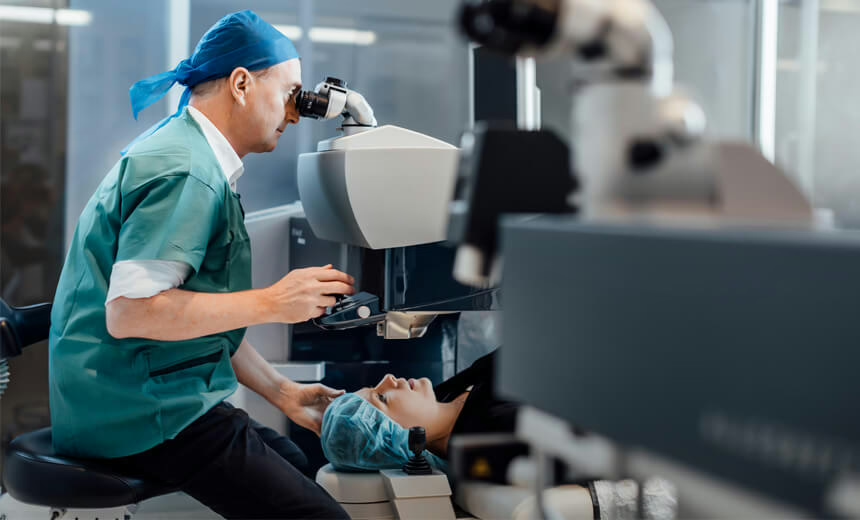Subscribe to eyeMatters periodic news
"*" indicates required fields
Does laser eye surgery hurt?

Having performed laser eye surgery for more than 20 years, it comes as no surprise to me that many people find the idea of this procedure quite daunting.
In particular, a number of my patients express concern about remaining awake throughout the procedure, fearing that it will lead to pain and discomfort. In fact, laser eye surgery takes around 10 to 20 minutes and is considered a safe elective procedure.
If you choose an experienced surgeon and a reputable clinic, there should be no pain during the surgery. Depending on the type of procedure and your general eye health, you may experience some mild, short-term discomfort as you recover.
The following guide can be helpful for those considering laser eye surgery.
Eye to eye: what does laser eye surgery actually involve?
For laser eye surgery at Vision Eye Institute Melbourne, we offer a free initial assessment to check your eye health and current prescription requirements. If you fit the eligibility requirements for laser eye surgery, and it is the most suitable treatment for you, your options include LASIK, PRK/ASLA or transPRK.
LASIK
Laser in situ keratomileusis (LASIK) is the most common laser eye surgery performed worldwide, largely due to the fact that it has the shortest recovery time.
LASIK is a two-step, two-laser procedure that involves the following steps:
- Before entering the laser suite, you will be given anaesthetic eye drops and a mild sedative – there are no needles or injections involved
- Once you’ve been escorted to the laser suite and you’re lying flat on the surgical bed, the procedure will begin and your surgeon will create a thin flap on the surface of your cornea using the femtosecond laser – you may experience minor discomfort as pressure is applied to your eye to create the flap, but you should feel no pain
- Your surgeon will then reshape your cornea with the excimer laser to correct your vision – once again, you should feel no pain
- Finally, your surgeon will place the corneal flap back in place.
PRK/ASLA
Photorefractive keratectomy (PRK), also known as advanced surface laser ablation (ASLA), was first performed in Australia around 30 years ago. While PRK is less common, it produces comparable results to LASIK and remains an important treatment option.
For example, PRK may be more suitable than LASIK in patients with thin or unusually shaped corneas, or in those with a history of dry eye.
PRK is a one-laser procedure that involves the following steps:
- After being given anaesthetic eye drops and a mild sedative, you will be escorted to the laser suite and asked to lie flat on the surgical bed – there are no needles or injections
- An eyelid holder will be used to help keep your eye open during the procedure – you may experience mild discomfort from the eyelid holder, but no pain
- Once you’re comfortable with the eyelid holder, your surgeon will first remove the surface ‘gel coat’ on your cornea, and then use the excimer laser to reshape your exposed cornea – your eyes will be numb from the anaesthetic, ensuring you feel no pain
- Finally, a therapeutic ‘bandage’ contact lens will be placed on your eyes, which you will need to keep in place for around 4–5 days to assist with healing.
- There are several techniques used to remove the gel coat on your cornea. For example, your surgeon may use dilute alcohol drops and/or a surgical instrument or device, or the excimer laser (see more on transPRK below).
TransPRK
For patients undergoing transPRK, the steps are the same as those outlined above for PRK except that the excimer laser is used to remove the gel coat and reshape the cornea in a single step. There is no need for alcohol drops or surgical instruments, and no direct contact is made with your eyes. For this reason, transPRK is also known as ‘no touch’ PRK.
As with PRK, you may experience mild discomfort during transPRK but no pain.
Burning questions: can lasers cause eye damage?
Both types of laser used in laser eye surgery (i.e. excimer and femtosecond) are pre-programmed before the procedure to ensure they are precisely guided by your specific eye measurements and refractive requirements. Additionally, an infrared eye tracker measures even the slightest eye movement and actively adjusts the laser beam into the correct position. As a result, the chance of eye damage from the lasers is virtually zero.
Another misconception about laser eye surgery is that it can burn your eyes. In part, this probably stems from preconceived ideas about laser beams and their uses (particularly in the movies and on TV!). Additionally, the excimer laser produces a ‘smoky’ smell when it fires, which people tend to associate with heat and burning.
In reality, the excimer laser uses gas to produce energy and is considered to be a ‘cool’ laser. When the laser beam is pulsed onto the surface of the eye, it vaporises very small amounts of corneal tissue without producing any heat or burning. The excimer laser is so precise that it can split molecules, which releases carbon atoms into the air. For a few seconds, these carbon atoms leave a ‘smoky’ smell in the air.
Standing corrected: how long will recovery take?
Following laser eye surgery, you will be discharged and asked to rest. You will also be scheduled for a follow-up appointment with your surgeon, either later that day or on the following day.
As each of the laser eye surgery procedures outlined above affect your eyes in a different way, the recovery is slightly different for LASIK versus PRK and transPRK.
LASIK
After LASIK, your eyes may sting or burn for around 6–12 hours after the anaesthetic wears off. This sensation is generally mild and can be managed with over-the-counter painkillers such as paracetamol, if pain relief is necessary.
For most people, their eyes usually feel comfortable again by the following morning. As already mentioned, this burning sensation is never the result of heat or eye damage from the lasers.
A possible side-effect of LASIK is dry eye, which is common for a few weeks or months after surgery. This can cause eye symptoms such as stinging, itching, or a gritty sensation. In most cases, dry eye can be managed with lubricant drops and usually resolves on its own. If dry eye persists, there is generally another underlying cause unrelated to laser eye surgery.
PRK and transPRK
PRK/ASLA and transPRK generally result in some degree of discomfort and a longer visual recovery time compared to LASIK. This is because the top layer of the cornea is disturbed and takes longer to settle after surgery. Generally, this discomfort resolves in around 2–3 days, once the top layer of corneal cells has grown back.
To manage any pain or discomfort after PRK/ASLA or transPRK, you will be given a post-operative pack containing anaesthetic drops, painkillers and sedatives.
Final view: what do qualified healthcare professionals say?
With so much information (and misinformation) available at your fingertips, it can be difficult to separate the facts from fiction on any medical or surgical procedure. For this reason, it’s extremely important to seek information provided or endorsed by a suitably qualified healthcare professional – in this case, an ophthalmologist.
To recap the key facts, it’s important to remember that laser eye surgery in our clinic is a bladeless procedure performed using precisely controlled, cool-temperature lasers. Some patients may experience minor discomfort during surgery, and possibly some mild pain during recovery, but never any heat or burning.
Many clinical studies have shown laser eye surgery to be very safe and effective but any surgical procedure still carries some risk of complications. Consult your ophthalmologist for a detailed discussion about the benefits and risks for you.
References
- Lawless MA, Cohen P, Rogers C. Excimer laser photorefractive keratectomy: first Australian series. Med J Aust. 1992 Jun 1;156(11):812.
- Choice. A guide to laser eye surgery. NSW, 11 August 2020. Available at https://www.choice.com.au/health-and-body/optical-and-hearing/optical/articles/guide-to-laser-eye-surgery [Accessed 6 January 2021].
- Healthdirect. Laser eye surgery. NSW, 2019. Available at https://www.healthdirect.gov.au/laser-eye-surgery [Accessed 6 January 2021].
- Wilkinson JM, Cozine EW, Kahn AR. Refractive Eye Surgery: Helping Patients Make Informed Decisions About LASIK. Am Fam Physician 2017;95(10):637–44.
- Murueta-Goyena A, Cañadas P. Visual outcomes and management after corneal refractive surgery: A review. J Optom 2018;11(2):121–29.
- Shortt AJ, Allan BDS, Evans JR. Laser‐assisted in‐situ keratomileusis (LASIK) versus photorefractive keratectomy (PRK) for myopia. Cochrane Database Syst Rev 2013; 1: CD005135.
- Somani SN, Moshirfar M, Patel BC. Photorefractive Keratectomy. In: StatPearls [Internet]. Treasure Island, FL: StatPearls Publishing; 2020.
- SCHWIND eye-tech-solutions. Frequently asked questions from patients. Germany, 2020. Available at https://www.eye-tech-solutions.com/en/patients/faq [Accessed 6 January 2021].
The information on this page is general in nature. All medical and surgical procedures have potential benefits and risks. Consult your ophthalmologist for specific medical advice.
Date last reviewed: 2025-05-20 | Date for next review: 2027-05-20

